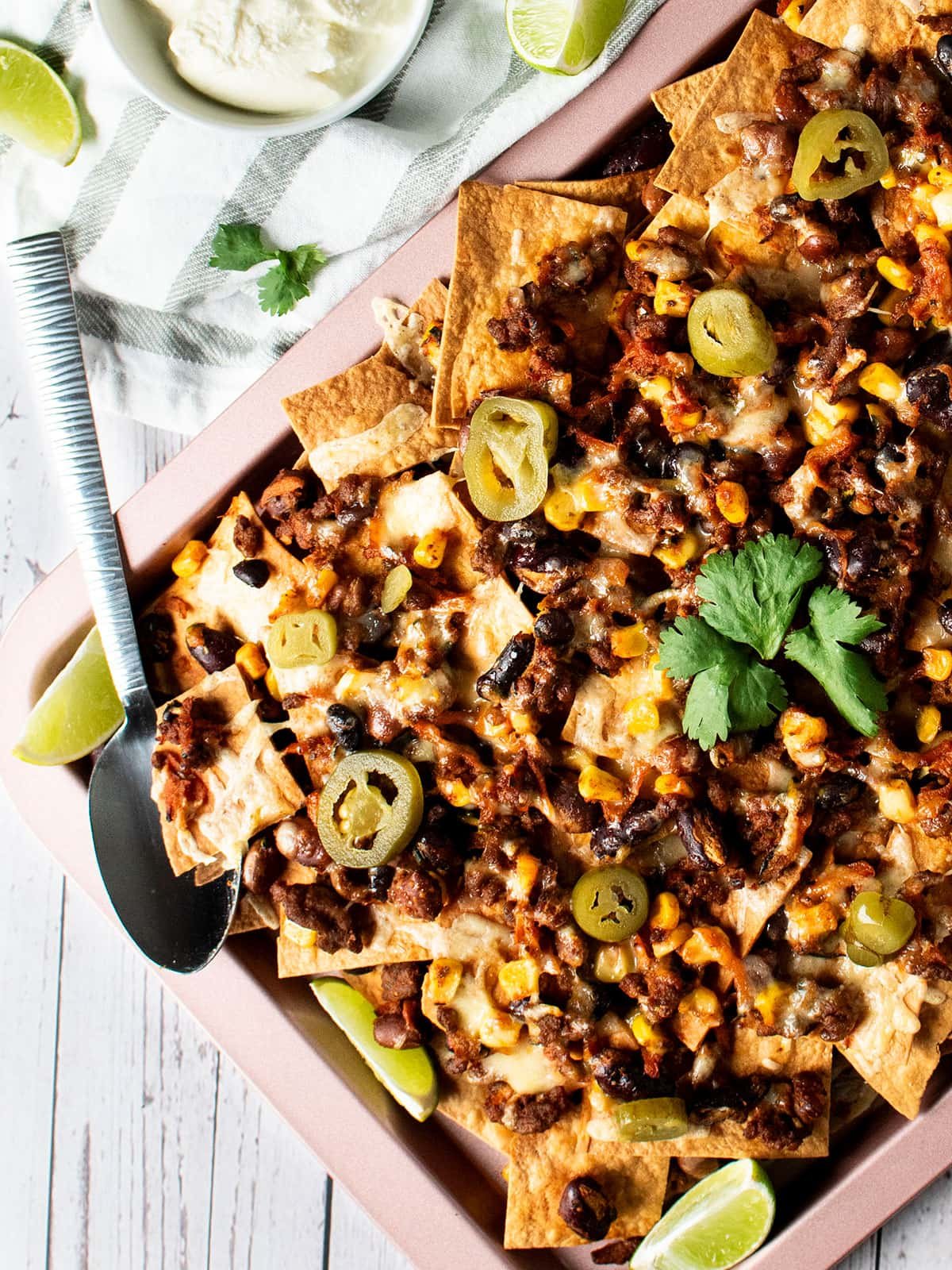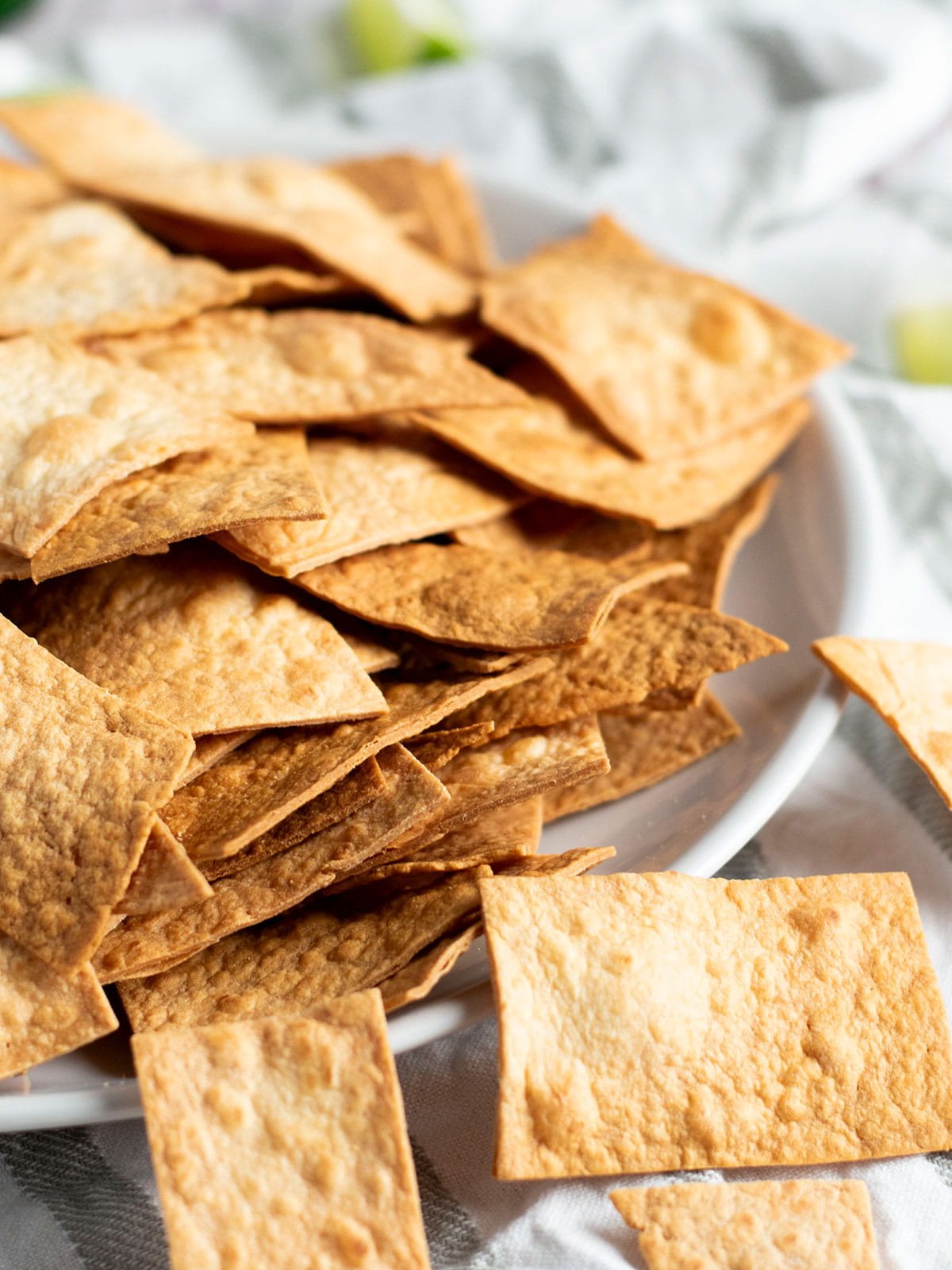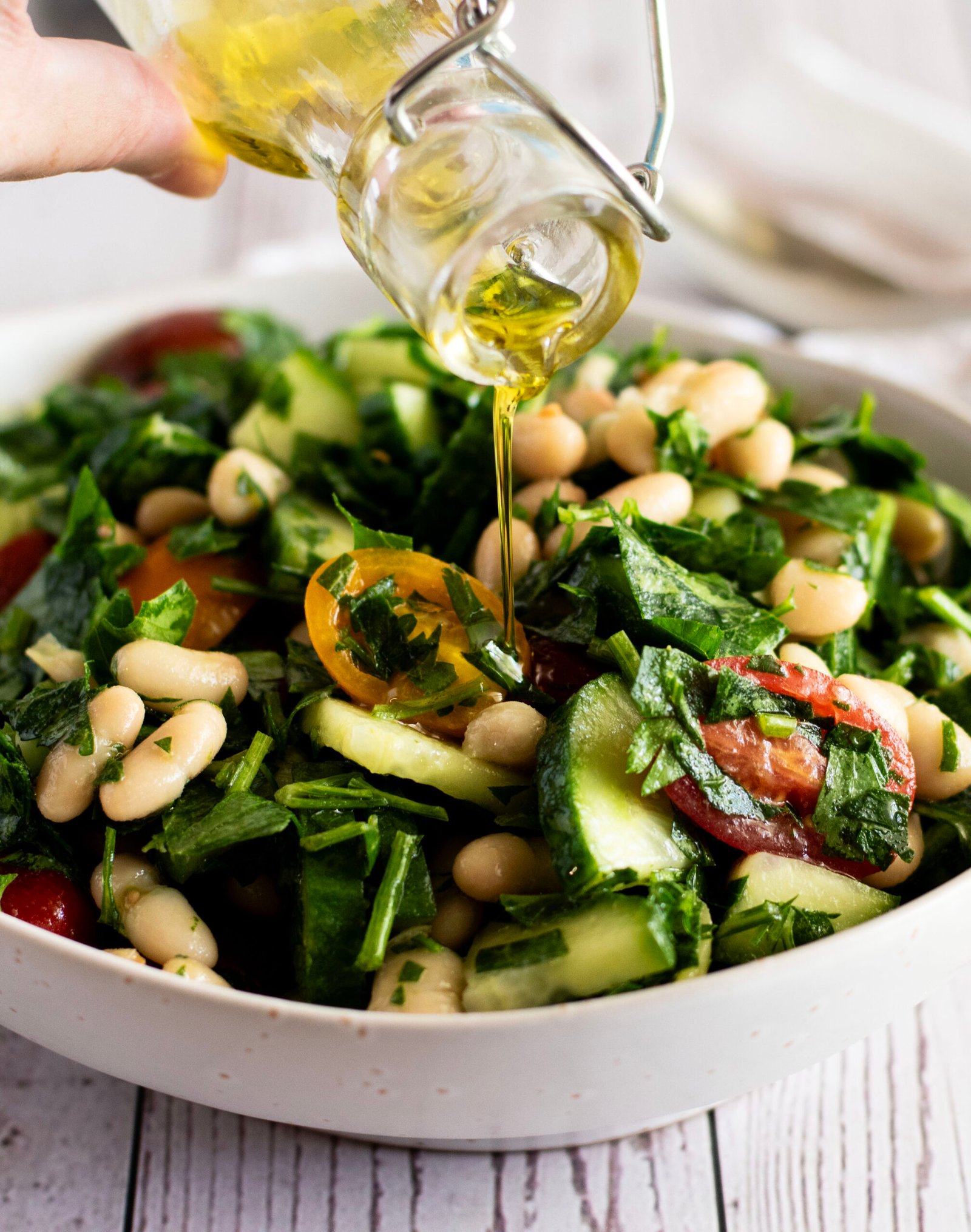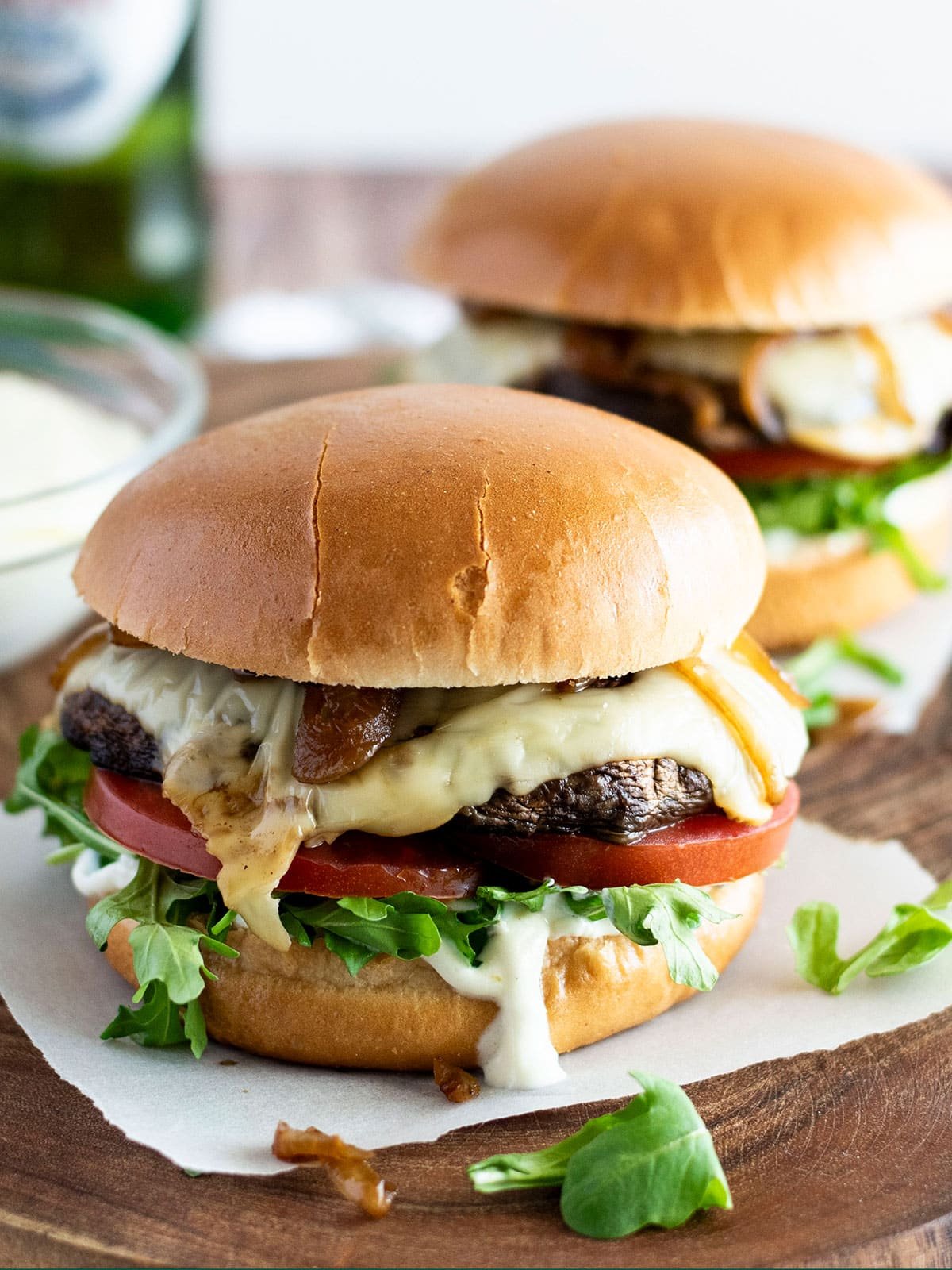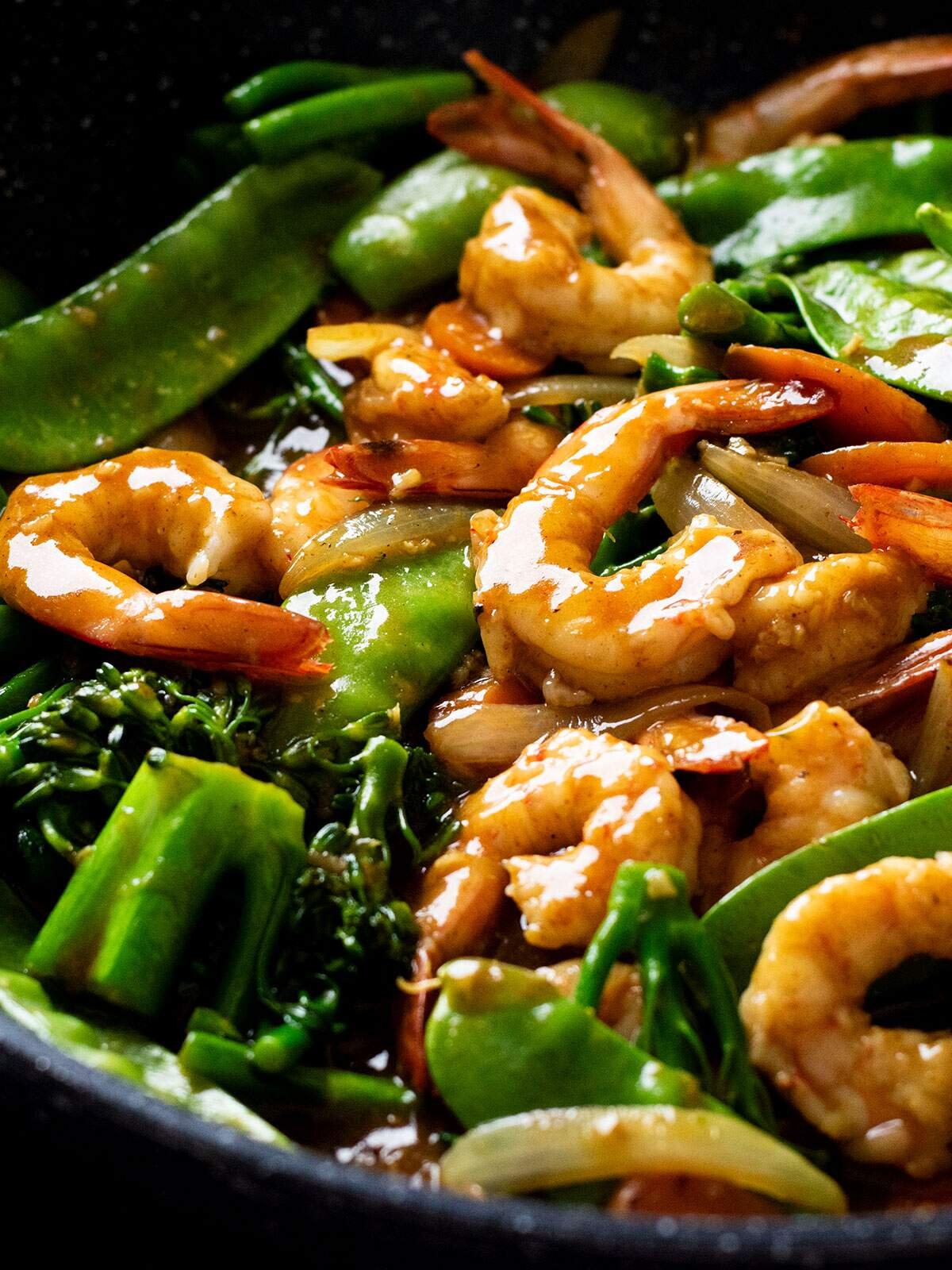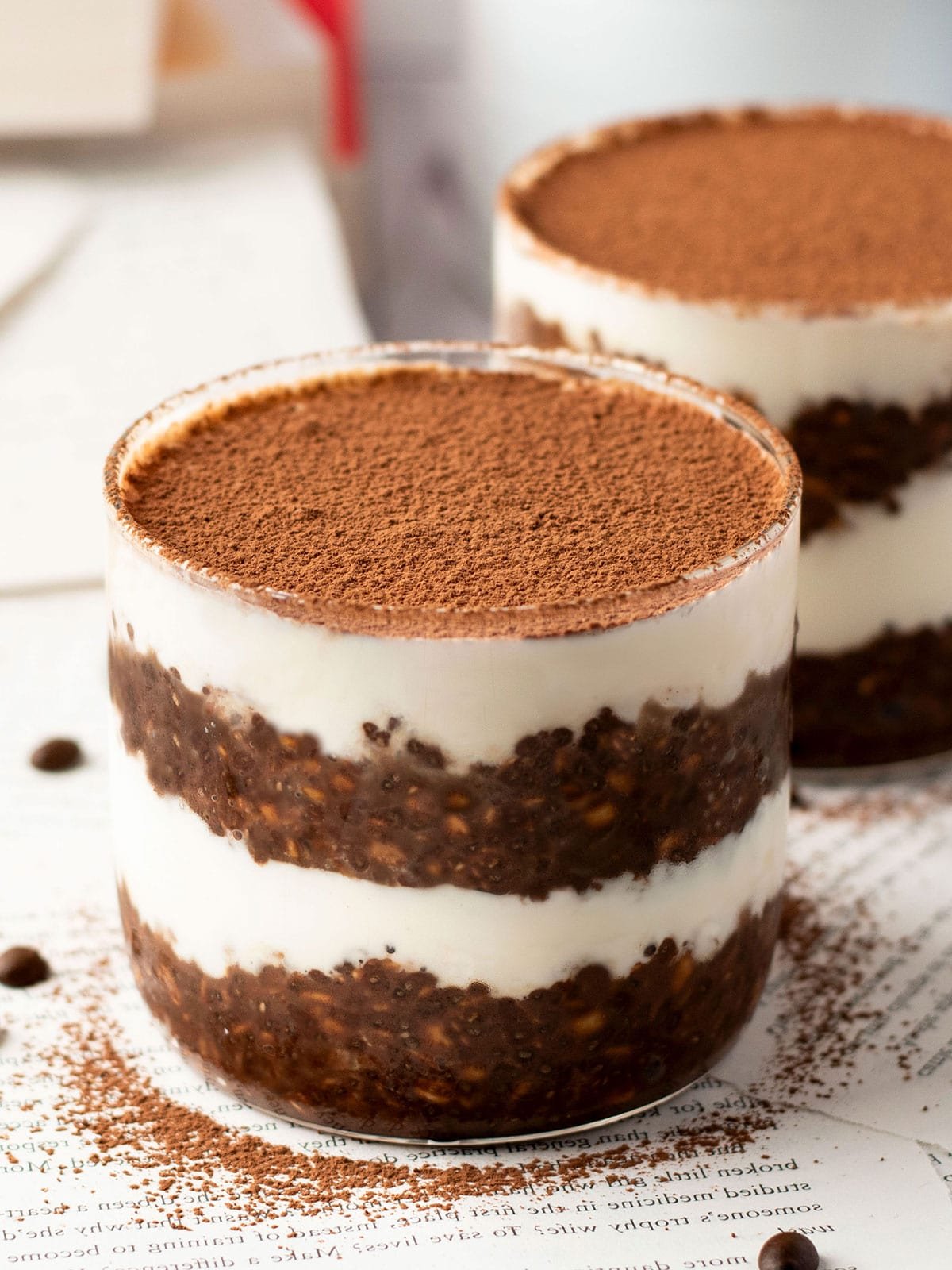Tandoori Salmon with Dill Cucumber Raita
This Baked Tandoori Salmon with Dill Cucumber is the perfect Indian recipe for a quick and easy mid-week meal. Tender baked salmon, coated in a smoky and mildly spicy Tandoori marinade, served with a refreshing raita made with cucumber, dill and mint.
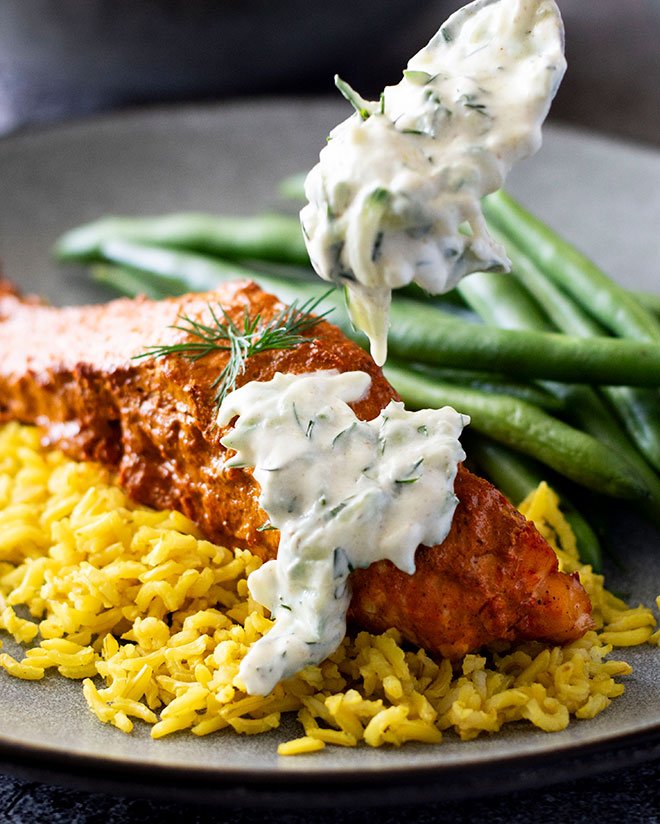
Why you’ll love this Tandoori Salmon
When thinking of Tandoori, my mind instinctively goes to chicken (like most people, I’m sure). However, this Indian marinade also goes surprisingly well with salmon! This recipe gives those big flavours Tandoor is known for, all while being super easy and quick to make.
Kashmiri chilli powder and smoked paprika are the secret to making authentic Tandoori at home. These spices give the bright red colour, warm chilli heat and that signature slightly smoky flavour of Tandoori, but in your own oven (no Tandoor needed).
This Tandoori salmon recipe is the perfect mid-week dinner solution, as it can be ready in less than 30 minutes! Marinate the salmon in the yoghurt spice mix, then bake it in the oven for 10 minutes, and you’re done!
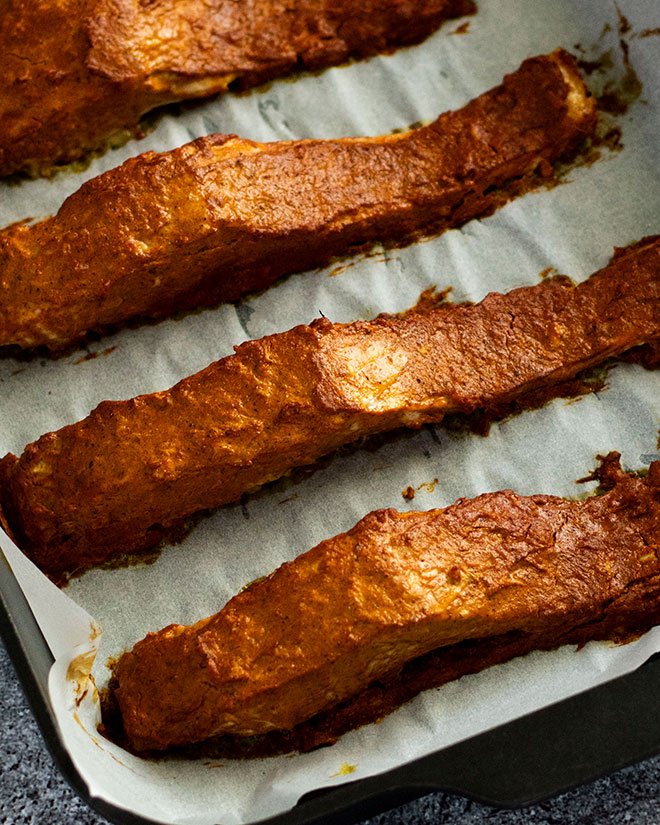
Pairing the salmon with a fresh and herby dill cucumber raita takes this dish to the next level. The cucumber, Greek yoghurt, and mint help to balance out the spiciness of the chilli powder, while dill compliments the flavour of the salmon.
There are also many health benefits that come with this recipe. You’ve got the healthy fats and protein from the salmon, the probiotics from the Greek yoghurt, and the antioxidants from all the spices!
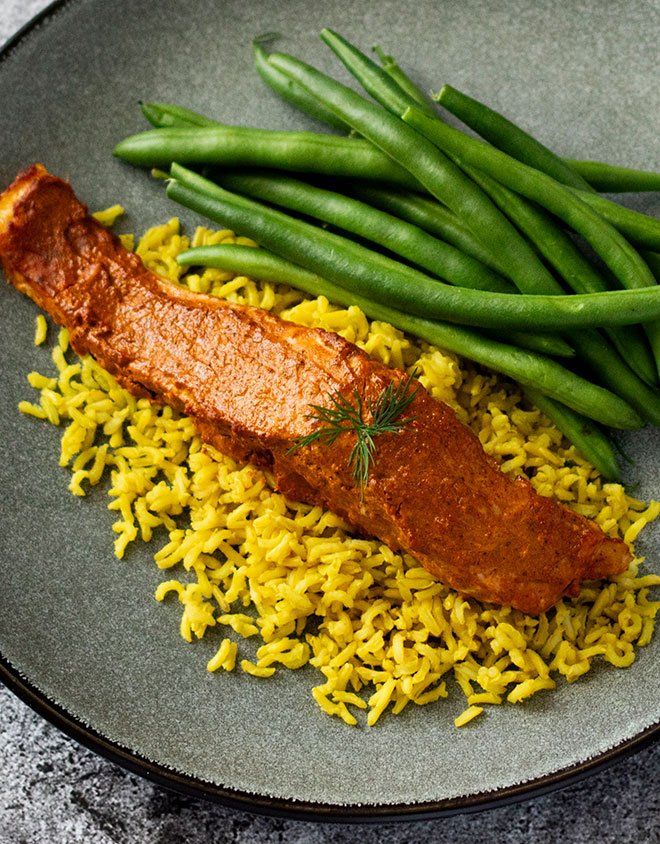
Recipe suitability
Although low in dietary fibre, you can increase it by pairing this recipe with some high fibre vegetables and brown rice as side dishes. This recipe uses fermented foods, which makes it a great option for supporting gut health. It contains 35g of protein per serve, making this a high-protein meal. While it is low in sodium, it is not low in fat or cholesterol. However, this recipe uses heart healthy ingredients, so I would classify this recipe as heart friendly. As this recipe uses low GI ingredients and contains under 15g of carbohydrates, it is diabetes friendly. It is also gluten free.
Tandoori Salmon with Dill Cucumber Raita ingredients
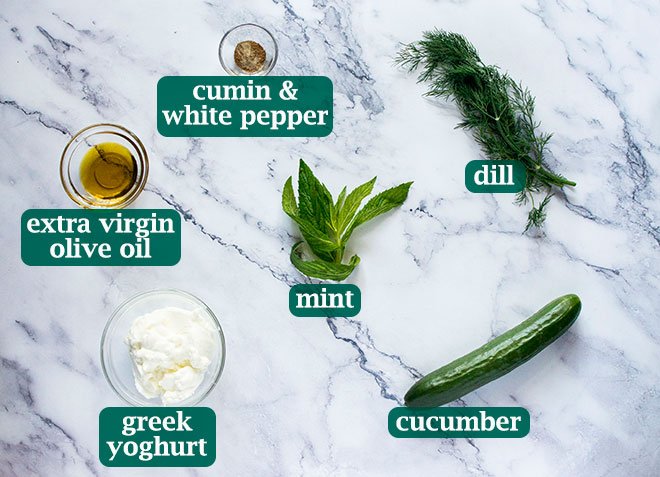
DILL CUCUMBER RAITA
- Cucumber – Grated, with the excess liquid squeezed out.
- Greek yoghurt – Forms the base for the raita. Greek yoghurt is a fermented probiotic food, meaning that it contains live bacteria that are beneficial to our gut health! It is also a rich source of vitamin B12, which is needed to form new blood cells and maintain nervous system function.
- Extra virgin olive oil – Is rich in monounsaturated fatty acids, which research suggests are beneficial for heart health. EVOO is also rich in vitamin E, an essential nutrient and other antioxidants, which may help reduce inflammation and risk factors associated with heart disease. Regularly eating EVOO is also encouraged in the Mediterranean diet, which research shows has many health benefits.
- Dill – Gives the raita a mild but fresh, citrus-like taste that pairs perfectly with salmon.
- Mint – Contains the chemical menthol, which has a cool sensation that compliments the mild spiciness of the Kashmiri chilli powder.
- Spices – Ground cumin and white pepper.
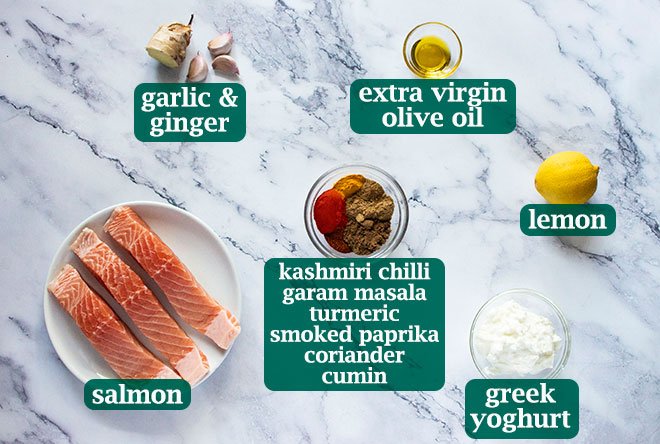
TANDOORI SALMON
- Salmon fillets – Skinless. Salmon is a great source of protein, which assists with healing after injury, bone health and helps us maintain our muscle mass as we age. Being an oily fish, it is also rich in essential omega-3 fatty acids, which research suggests may help reduce inflammation, lower blood pressure and decrease risk factors for cardiovascular diseases.
- Greek yoghurt – Helps to tenderise and creates a coating around the salmon that prevents it from drying out.
- Extra virgin olive oil – A healthy fat that helps to thin the marinade and cook the salmon.
- Garlic and ginger – Key ingredients in Indian cooking that give extra flavour. According to research, garlic and ginger may help reduce risk factors associated with heart disease, contain antioxidants that protect against free radicals, and assist with immune function.
- Lemon juice – For a touch of acidity and flavour.
- Kashmiri chilli powder – Gives the marinade its signature red colour and a bit of mild heat. I found Kashmiri chilli powder at my local Coles supermarket. Other places you can easily find it are Indian supermarkets, or I have also seen it on Amazon.
- Garam masala – An Indian spice blend you can find at most supermarkets.
- Turmeric – Research has found that turmeric contains a potent antioxidant called ‘curcumin’, which may help reduce bodily inflammation. Don’t forget to wear gloves when handling, or you’ll risk ending up with yellow fingers!
- Smoked paprika – Adds an extra smokiness for depth of flavour and to make up for not using a tandoor oven.
- Other spices – I also used ground coriander and cumin.
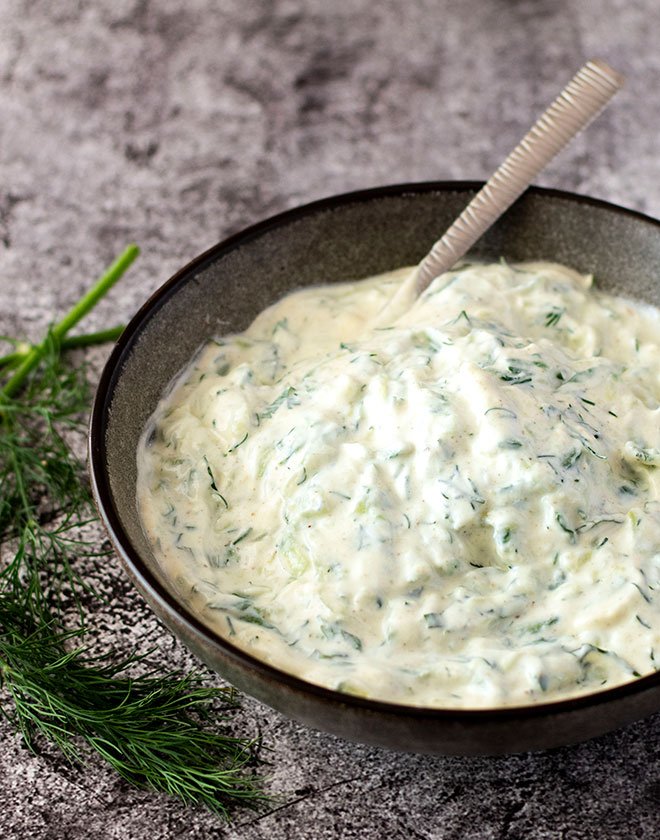
How to make Tandoori Salmon
DILL CUCUMBER RAITA
- Place the cucumber into a small bowl. Add the remaining ingredients and stir to mix. Place the raita in the fridge until ready to serve.
- Coarsely grate the cucumber using a box grater. Using either your hands or paper towel/tea towel, squeeze the grated cucumber and remove all the excess liquid.

TANDOORI SALMON
- Mix the marinade ingredients together in a large bowl. Add the salmon fillets to the bowl, coat them with the marinade and set aside for at least 20 minutes. Do not marinade the salmon for any longer than 30 minutes or you risk the fish becoming mushy due to the lemon juice. (If using your hands for this step, remember to wear gloves to prevent turmeric stains!).
- While the fish is marinating, preheat the oven to 190°C/375°F.
- Line a baking tray with baking paper. Remove the salmon fillets from the bowl and shake off any excess marinade. Place the marinated salmon fillets into the lined baking tray, leaving a space between each fillet. If there are still large chunks of marinade stuck to the salmon fillets, use a spoon to remove the excess.
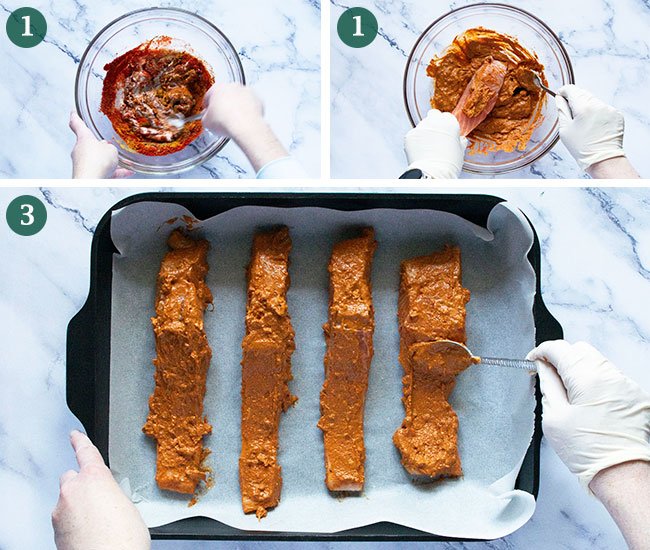
- Bake the salmon fillets for 10-12 minutes or until the salmon is cooked. Remove the salmon fillets from the oven, set aside to rest for 5 minutes.
- Serve the baked salmon fillets hot with turmeric rice, vegetables, and the dill cucumber raita.
Cooked Salmon Internal Temperature
These are the recommended internal temperatures for the salmon to reach during cooking. Once pulled out of the oven, the salmon needs to be rested for 5 minutes to reach it’s ideal tempertature.
- Medium rare (restaurant) – 49-50°C / 120 – 125° – will inrease to 53°C / 127°F – will be moist and tender.
- Medium (FDA recommendation) – 60°C / 140°F – will increase to 63°C / 145°F once rested, not as juicy as medium rare, but still very tender.
- Well done – 65°C / 149°F – Fully cooked, no pinkness.
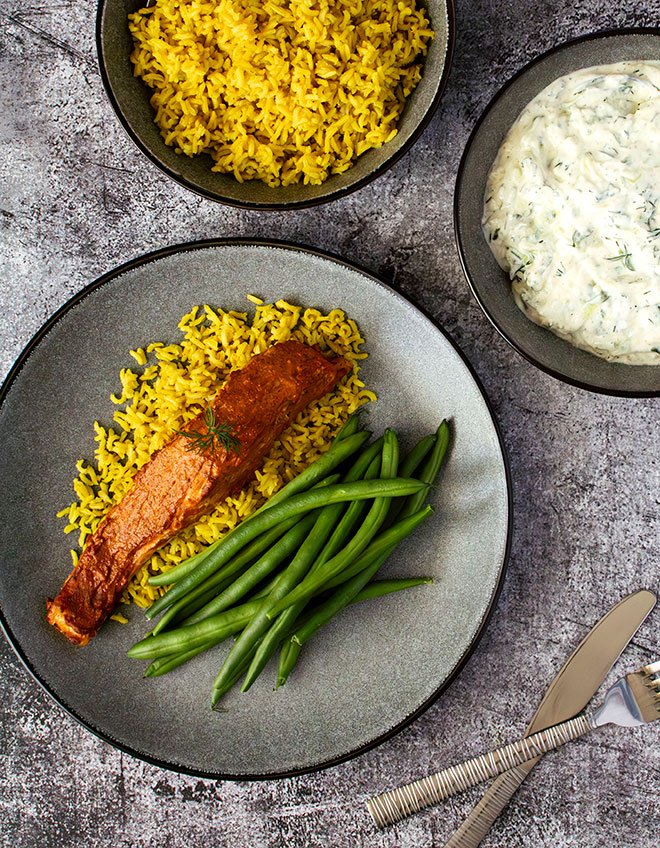
Serve with
This recipe goes perfectly with saffron rice, or for a cheaper alternative, turmeric rice (I used brown basmati rice for more dietary fibre). Just cook the rice according to packet instructions using the absorption method with your spice of choice.
Hint: For fluffy rice, take the saucepan off the heat once the rice is cooked and allow to sit for 5 minutes with the lid on before putting in the fridge/serve immediately.
Storage
Both the tandoori salmon and dill cucumber raita will last in an airtight container in the fridge for 2-3 days. The salmon may be frozen for up to 3 months, let thaw completely before reheating.
To reheat the salmon without drying it out, place it on top of a small pile of rice on a plate. Cover the salmon and rice with a piece of damp paper towel and heat in the microwave for 1-2 minutes or until hot.
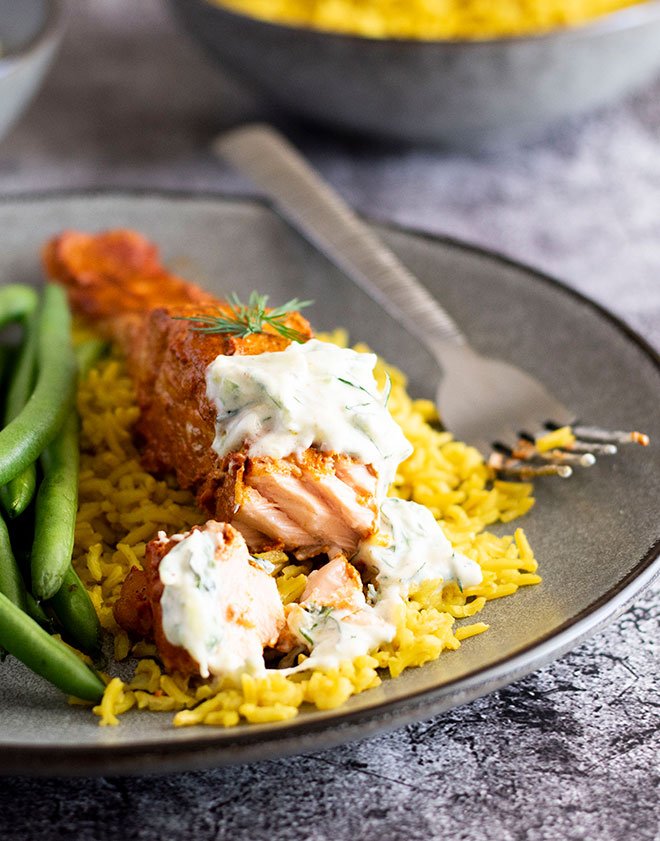
Tips & Substitutes
If you can’t find Kashmiri chilli powder, use sweet paprika instead and add some chilli powder to your desired heat level. I recommend doing this and removing the chilli powder or adding only a tiny amount if you’re making this dish for children or people with poor chilli tolerance.
To make this recipe dairy-free, substitute the Greek yoghurt for a plant-based yoghurt. Alternatively, you can leave the Greek yoghurt out of the marinade.
You can marinade the salmon fillets for a shorter time, however, they may not be as flavourful. This marinade would easily lend itself to other types of protein, such as chicken, beef or lamb. You can also use it on different types of fish, but you may need to adjust your cooking time if using meatier fish such as barramundi.
Hungry for more?
Don’t forget to subscribe to my newsletter and follow along on Facebook, Instagram and Pinterest for all the latest updates!
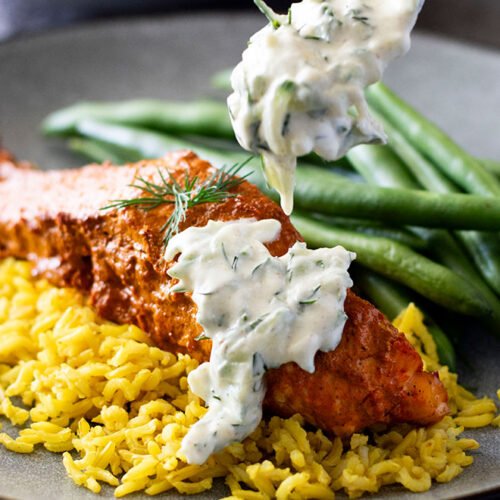
Tap or hover to scale
Ingredients
Dill Cucumber Raita
- 2/3 cup Greek yoghurt, low fat (Note 2)
- 1 medium lebanese cucumber, grated
- 2 tbsp dill, roughly chopped
- 1 tbsp fresh mint, thinly sliced
- 2 tsp extra virgin olive oil
- 1/2 tsp ground cumin
- 2 dashes white pepper
Tandoori Salmon
- 4x 120 g skinless salmon fillets (Note 1)
- 1/2 cup Greek yoghurt, low fat (Note 2)
- 1 tbsp extra virgin olive oil
- 1 tbsp lemon juice
- 4 cloves garlic
- 1 1/2 tsp grated ginger
- 1 tbsp Kashmiri chilli powder (Note 3)
- 2 tsp gara masala
- 1 1/2 tsp ground coriander
- 1 1/2 tsp ground cumin
Instructions
Dill Cucumber Raita
- Coarsely grate the cucumber using a box grater. Using either your hands or paper towel/tea towel, squeeze the grated cucumber and remove all the excess liquid.
- Place the cucumber into a small bowl. Add the remaining raita ingredients and stir tomix. Place the raita in the fridge until ready to serve.
Tandoori Salmon
- Mix the marinade ingredients together in a large bowl. Add the salmon fillets to the bowl, coat them with the marinade and set aside for 20 minutes. Do not marinade the salmon for longer than 30 minutes; otherwise, you risk the fish becoming mushy due to the lemon juice. (If using your hands for this step, remember to wear gloves to prevent turmeric stains!).
- While the fish is marinating, preheat the oven to 190°C/375°F.
- Line a baking tray with baking paper. Remove the salmon fillets from the bowl and shake off any excess marinade. Place the marinated salmon fillets into the lined baking tray, leaving a space between each fillet. If there are still large chunks of marinade stuck to the salmon fillets, use a spoon to remove the excess.
- Bake the salmon fillets for 10-12 minutes or until the salmon is cooked (Note 4). Remove the salmon fillets from the oven, set aside to rest for 5 minutes.
- Serve the baked salmon fillets while hot with turmeric rice, vegetables, and the dill cucumber raita.
Notes
- Salmon – Needs to be skinless, as the skin will not crisp up while covered in the marinade.
- Greek yoghurt – Can be substituted for a plant-based yoghurt to make this recipe dairy free.
- Kashmiri chilli powder – Can be substituted for paprika instead and add some chilli powder to your desired heat level. I recommend doing this and removing the chilli powder or adding only a tiny amount if you’re making this dish for children or people with poor chilli tolerance.
- Internal temperatures for cooked salmon – These are the recommended internal temperatures for the salmon to reach during cooking. Once pulled out of the oven, the salmon needs to be rested for 5 minutes to reach it’s ideal tempertature.
- Medium rare (restaurant) – 49-50°C / 120 – 125° – will inrease to 53°C / 127°F be moist and tender.
- Medium (FDA recommendation) – 60°C / 140°F – will increase to 63°C / 145°F once rested, not as juicy as medium rare, but still very tender.
- Well done – 65°C / 149°F – Fully cooked, no pinkness.
- Air fryer – Cook the salmon fillets at 180°C/355°C for 3-4 minutes for medium rare, or 4-5 minutes. Allow to rest for 5 minutes before serving.
- Marinade – You can marinade the salmon fillets for a shorter time, however, they may not be as flavourful. Can be used on other proteins such as chicken, beef or lamb or other types of fish. Cooking time will vary.
- Nutrition – Calculated per serve, assuming 4 serves (not including rice or side vegetables).


